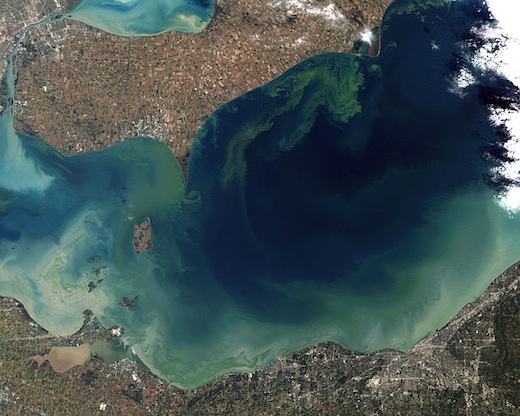
While Detroit has been justifiably making headlines because of the manmade water crisis there, just south over the Michigan-Ohio state line another manufactured water crisis has erupted. Toledo, Ohio faced a weekend water ban after tests showed toxins in the city’s drinking water supply.
According to The New York Times, residents of Toledo were told not to use their water for drinking, cooking or brushing their teeth. Meanwhile, children and the elderly, and those with compromised immune systems, were told not to use the water for bathing. Toledo isn’t the first city in the region to face this problem; last year Carroll Township experienced a similar ban. In 2010, Grand Lake St. Marys was so bad, officials had to warn people not to even touch the water, and it’s having problems again this year.
For Toledo, the problem is algae blooms in Lake Erie. The lake is the source of drinking water for 11 million people, but lately, runoff mainly from agriculture, but also from crumbling wastewater infrastructure, has lead to increasing algae blooms in the summer. Like most areas with large factory farms that apply huge amounts of manure to farm lands, the soil in Ohio is supersaturated with nutrients. But when rains come, that excess is carried away by the water and ends up in Lake Erie. There, the nutrients feed algae, creating the large blooms.
The algae can produce powerful toxins that, according to NOAA, can cause everything from rashes, to gastroenteritis, to neurotoxicity. Clearly it’s a major problem, a public health hazard, and something you’d think Ohio officials would be rushing to address.
Instead of fixing the problem, Ohio passed a bill creating a fertilizer applicator certification program, but the bill explicitly exempts manure. I’ll say that again: a law to create a fertilizer certification program exempts manure. It also includes a voluntary, not mandatory, nutrient management plan program. So, Ohio’s solution to this problem is a program that exempts manure, and another that is voluntary. The mind boggles. Or at least it would, if weren’t for the fact that the Ohio Farm Bureau championed the legislation. It’s a story we see across the country-waterways in trouble and agribusiness offering false solutions.
Across Ohio another false solution is being proposed for the Ohio River. This time it’s the old canard that the way to reduce pollution is to allow polluters to pay-to-pollute. The idea is that if we allow polluters to trade the right to pollute, they will reduce their pollution. We’ve seen this one before. It doesn’t work, but that doesn’t stop corporate interests from pushing it as a solution.
We know why these false solutions keep on being offered – the corporate interests that benefit from creating large amounts of fertilizer in the form of animal manure refuse to take responsibility for the pollution that manure creates. Instead, they seek to give the appearance of action while residents bear the burden of unclean water: drinking water bans, aquatic dead zones, lakes closed to swimming.
Take action today to protect Ohio’s water from factory farms!
This article was reposted from Food and Water Watch with permission.
Photo: The green scum shown in this image taken in October 2011 is the worst algae bloom Lake Erie has experienced in decades. Vibrant green filaments extend out from the northern shore. (Wikipedia/NASA)












Comments